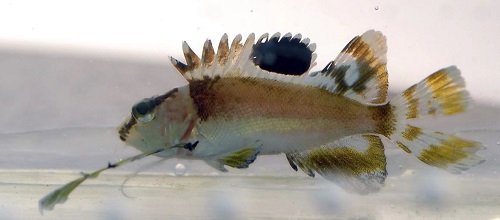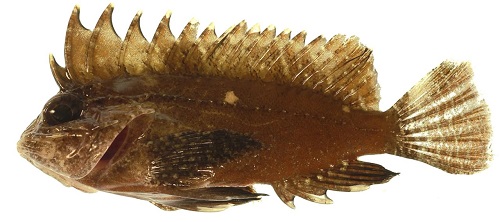
This soldierfish (Gymnapistes marmoratus) has one saber in and the other saber out on either side of its head.
Credit: Copyright American Society of Ichthyologists and Herpetologists
If you invite the venomous, armored stonefish to a party, know this: It’s going to bring not one, but two “switchblades” — and it can’t check them at the door, because these weapons are embedded in its skull.
Scientists recently discovered these switchblades, or “lachrymal sabers,” in a group of stonefish — rare, dangerous fish that live in the coastal waters of the Indo-Pacific.
“I don’t [know] why this hasn’t been discovered before,” study lead researcher William Leo Smith, associate curator at the Kansas University Biodiversity Institute and Natural History Museum, said in a statement. “It’s probably because there are just one or two people that ever worked on this group.”
All of the stonefish Smith analyzed have a unique type of “switchblade” mechanism on their cheeks, just below the eyes.
“What makes this fish different in terms of the switchblade is that this bone [the lachrymal] is normally immobile, but these fishes can rotate the bone 90 degrees along the head-tail axis,” Smith, who is also a Kansas University associate professor of ecology and evolutionary biology, told Live Science.

The ocellated waspfish (Apistus carinatus), also has a lachrymal saber.Credit: Leo Smith
In essence, the spine pokes out from the side when it’s activated, like a dangerous mustache.
This rotating lachrymal saber is heavily spined, indicating that these fish use it as a weapon. When it’s not in use, the saber rests against the fish’s head, “safely pointing back and down,” Smith said.
However, when the fish goes “en garde,” it uses its cheek muscles (which are normally reserved for chewing) to pull on the upper jaw, which, in turn, rotates the spine “through a roly-poly-shaped locking mechanism,” Smith said.
Both male and female stonefish have lachrymal sabers. Depending on the individual, these spiny swords range in length from about half the width of the fish’s eye to about 2.5 times the width of the eye, Smith said. In general, large stonefish have smaller sabers, and smaller stonefish species have larger sabers, comparatively, he said.
One species (Centropogon australis) even has a saber that glows an eerie green, thanks to biofluorescence; the saber absorbs light and then re-emits it at a lower wavelength. In a dramatic light show, the rest of the fish’s head fluoresces red, the researchers wrote in the study.
The finding is 15 years in the making. It all started in 2003, when Smith was dissecting a stonefish he had kept as a pet, and he soon became the first scientist to grasp how the locking switchblade mechanism worked anatomically.

The wispy waspfish Paracentropogon longispinis has a lachrymal saber.
Credit: Leo Smith
While useful, the switchblade is just one of many defenses that stonefish likely use against predators; others include spikes, camouflage and some of the most powerful venoms in the world, which could kill even an adult human, Smith said.
“Of all the fishes I’ve studied, I haven’t yet been stung by any of these stonefishes,” Smith said in the statement. “There is an aquaculture for larger ones in Indonesia. That’s mind-boggling to me. The venom breaks down in our digestive system. But people eat lots of venomous species all over the world, even in the U.S.”
Stay updated with the latest Nigerian news from Information Nigeria




